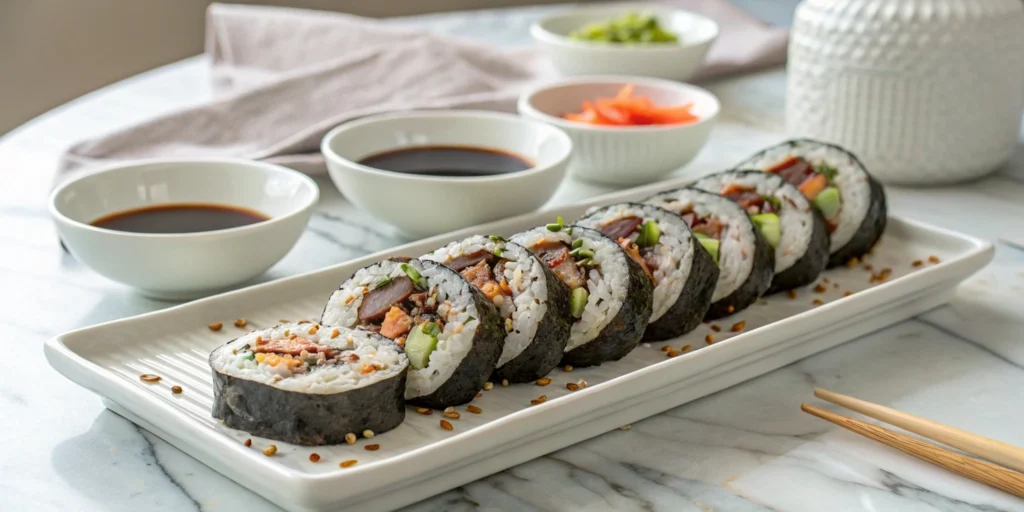
Table of Contents
Kimbap (김밥), a beloved Korean delicacy, is more than just a meal—it’s a tapestry of tradition, flavor, and creativity. As someone with Korean roots, this dish evokes memories of childhood, when my grandmother would guide me through the art of making kimbap, her handwritten recipe book open on the counter. Today, I’m sharing the steps to create your own masterpiece, just as it’s been done in my family for generations.
From its origins as a humble picnic snack to its modern-day status as a global favorite, kimbap is a dish that brings people together. Whether you’re hosting a party, packing a lunch, or simply exploring the world of Korean cuisine, this recipe is your gateway to a flavorful adventure.
What is Kimbap?
Kimbap (pronounced gim-bahp) is a Korean dish made of rice and various fillings rolled in dried seaweed. Its name comes from two Korean words: kim (seaweed) and bap (rice). While it’s often compared to sushi because of its appearance, kimbap is distinct in flavor and preparation.
Instead of sushi vinegar, gimbap rice is seasoned with sesame oil and salt, giving it a nutty aroma. The fillings are typically cooked or pickled, making it a versatile dish that doesn’t rely on raw ingredients.
Gimbap is often enjoyed as a portable meal—ideal for picnics, road trips, or a quick snack on a busy day. The best part? You can customize the fillings to suit your tastes or dietary preferences.
The History and Significance of Kimbap
The origins of kimbap are somewhat debated, but many believe it was inspired by Japanese sushi during the colonial period. However, Koreans made it their own by using local ingredients and cooking techniques.
In Korean culture, kimbap represents more than just food; it’s a way to show care and love. Preparing kimbap for someone is a thoughtful gesture, often seen during special occasions, school trips, and family gatherings.
Growing up, I remember the anticipation of opening a neatly packed lunchbox to find perfectly sliced gimbap rolls, each piece a bite-sized treasure of flavor. The memories tied to this dish are as rich as its taste.
Ingredients You’ll Need
Creating authentic gimbap starts with gathering the right ingredients. While the fillings are flexible, the essentials remain consistent:
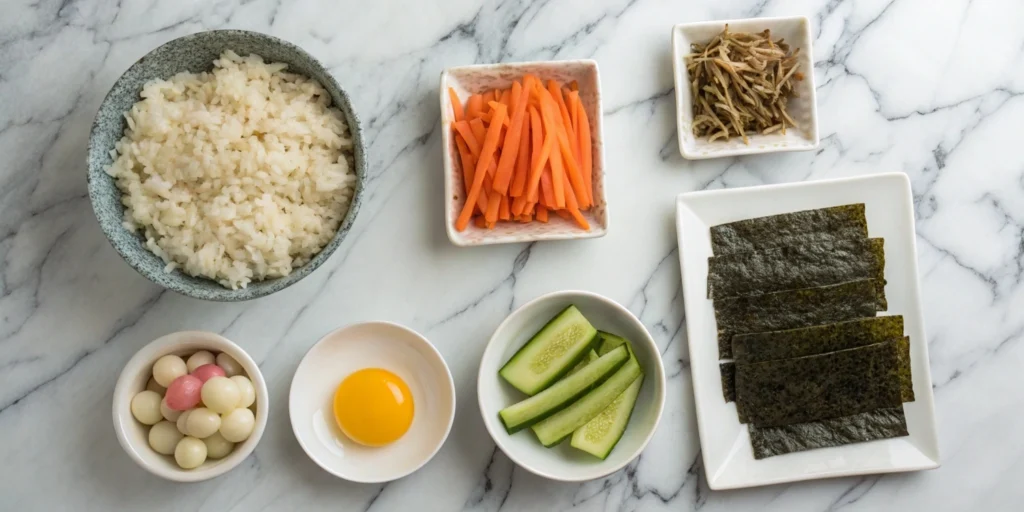
- 3 cups of cooked short-grain rice: Korean rice is sticky and perfect for rolling.
- 1 tablespoon sesame oil: Adds a nutty aroma to the rice.
- 1/2 teaspoon salt: To enhance flavor.
- 5 sheets of dried seaweed (gim): The foundation of every roll.
- 1 large carrot, julienned: Sautéed for a slight sweetness.
- 1 cucumber, cut into strips: For crunch and freshness.
- 3 eggs, beaten and cooked into an omelet: Protein-rich and tender.
- 1 pickled radish (danmuji), cut into thin strips: Provides a tangy contrast.
- 5 crab sticks or imitation crab: A traditional favorite, though optional.
- Cooked beef bulgogi or tofu (optional): For a savory twist.
- Sesame seeds: A final garnish for visual appeal.
- Soy sauce or spicy mayo: Perfect for dipping.
Feel free to swap out any of these ingredients for alternatives like avocado, spicy tuna, or roasted vegetables to make it your own.
Step-by-Step Guide to Making Kimbap
Step 1: Cook and Season the Rice
The rice is the cornerstone of gimbap, and its preparation sets the tone for the entire dish.
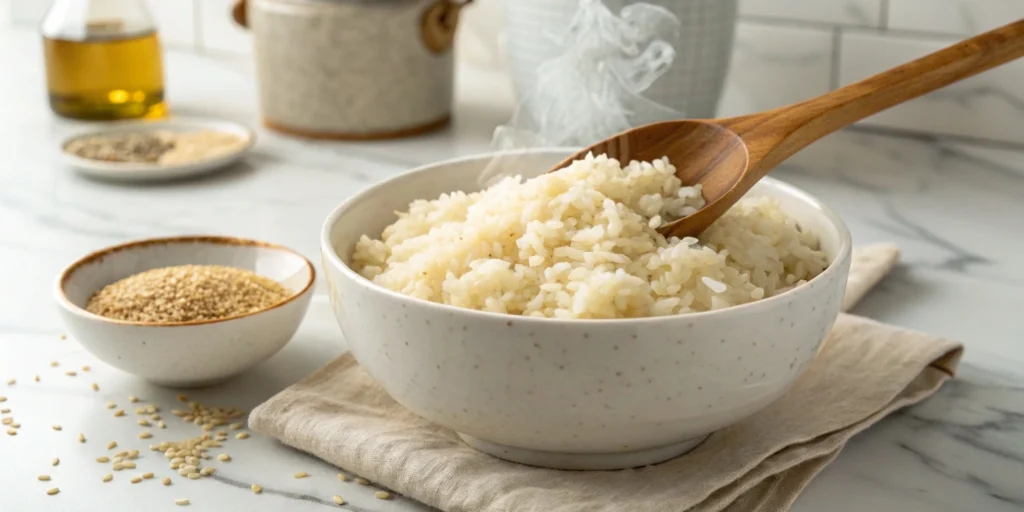
- Wash 3 cups of short-grain rice until the water runs clear.
- Cook the rice using a rice cooker or stovetop method.
- Once cooked, let the rice cool slightly before transferring it to a large bowl.
- Add 1 tablespoon of sesame oil and 1/2 teaspoon of salt to the rice. Mix gently to avoid crushing the grains.
Step 2: Prepare the Fillings
Each filling plays a crucial role in creating a balance of flavors and textures.
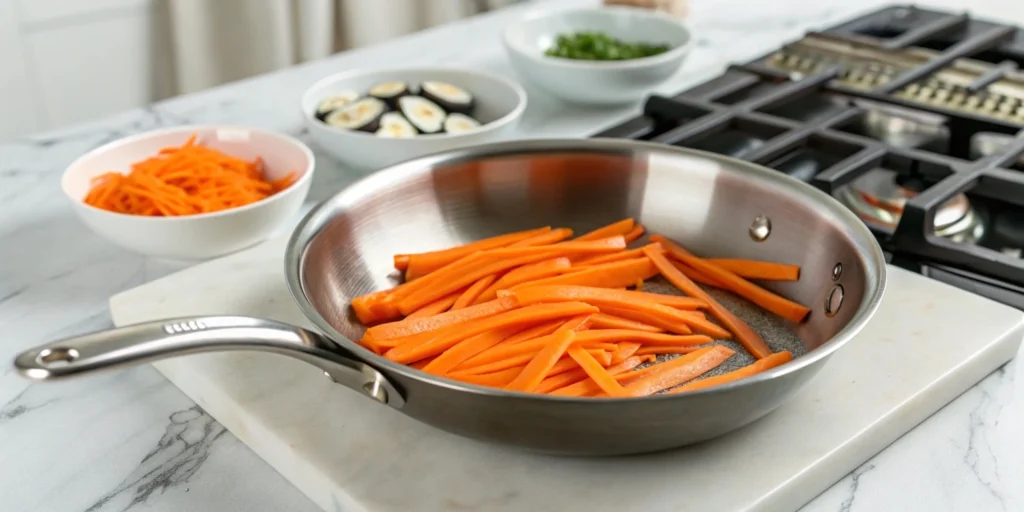
- Carrots: Sauté the julienned carrots in a small amount of oil until tender but not mushy.
- Cucumber: Slice into thin strips and pat dry to remove excess moisture.
- Eggs: Beat 3 eggs, cook into a thin omelet, and slice into strips.
- Pickled radish: Cut into long, thin strips for easy rolling.
- Optional proteins: Prepare cooked bulgogi or tofu as desired.
Step 3: Assemble Your Kimbap
Now comes the fun part—layering and rolling!
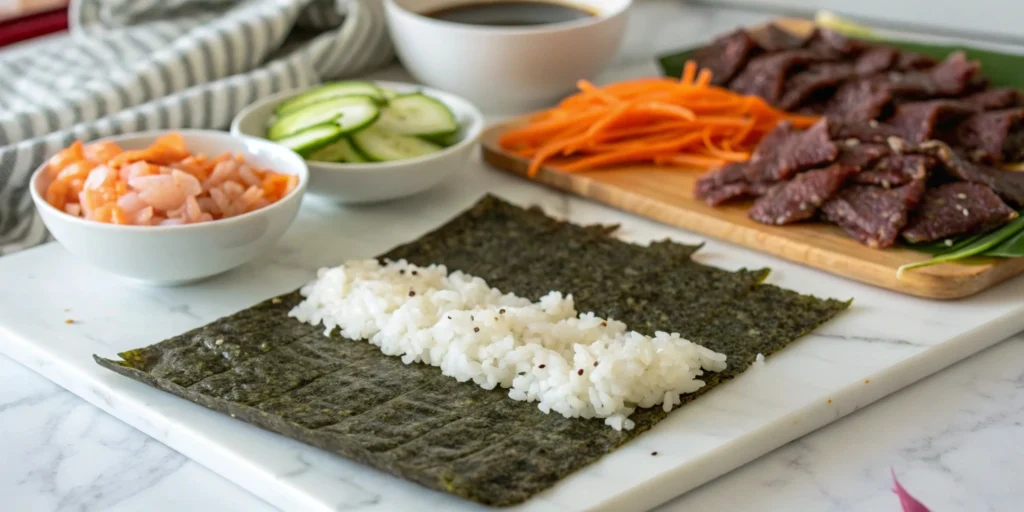
- Lay a sheet of dried seaweed (gim) shiny side down on a bamboo rolling mat.
- Spread a thin layer of rice over two-thirds of the seaweed, leaving the top edge bare for sealing.
- Arrange your fillings horizontally across the center of the rice.
Step 4: Roll Like a Pro
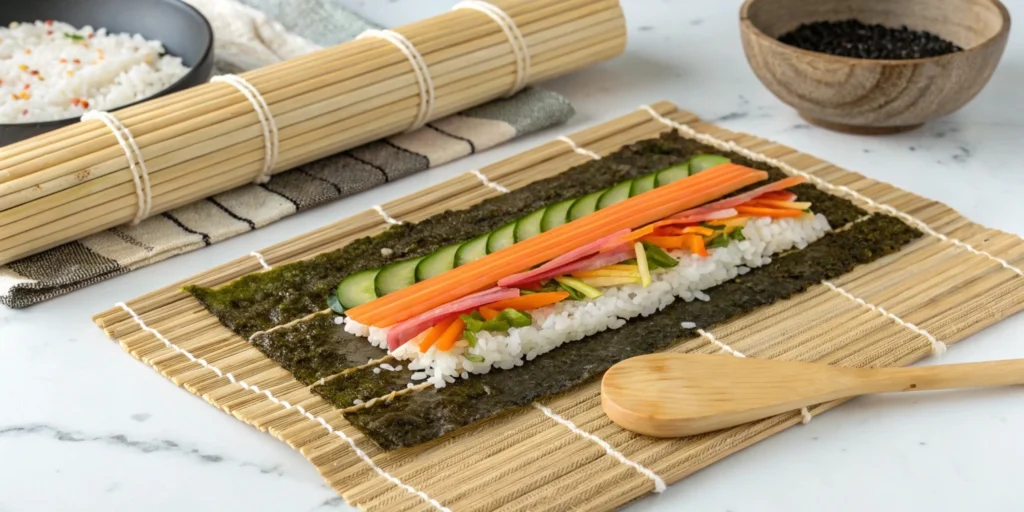
- Starting at the edge closest to you, use the bamboo mat to gently roll the seaweed over the fillings.
- Apply firm but even pressure to create a tight roll.
- Seal the roll by dabbing water on the bare edge of the seaweed.
Step 5: Slice and Serve
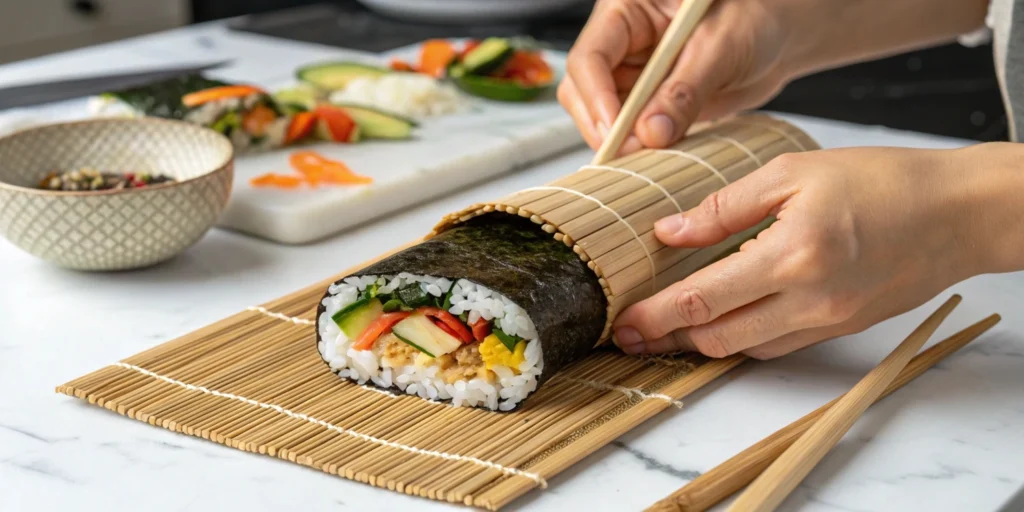
- Using a knife, slice the roll into 1-inch pieces.
- Arrange the pieces on a plate and sprinkle with sesame seeds for a polished look.
- Serve with soy sauce or spicy mayo on the side for an added kick.
Why You’ll Love Kimbap
Gimbap isn’t just a recipe—it’s a customizable canvas for your culinary creativity. Whether you prefer a vegetarian version or one loaded with protein, kimbap adapts to your preferences. It’s also a great way to involve kids in the kitchen, turning meal prep into a fun activity.
Nutritional Highlights
Kimbap isn’t just tasty; it’s also nutritious.
- Seaweed: Rich in iodine, calcium, and vitamins.
- Rice: A good source of energy-providing carbohydrates.
- Vegetables: Packed with fiber, vitamins, and antioxidants.
- Proteins: Support muscle repair and keep you full longer.
By incorporating fresh ingredients, you can enjoy a meal that’s as healthy as it is satisfying.
Tips for the Perfect Kimbap
- Choose the right rice: Short-grain rice ensures stickiness.
- Don’t overfill: Keep the rolls manageable for clean slicing.
- Invest in a bamboo mat: It simplifies the rolling process.
- Experiment: Add kimchi, avocado, or even cheese for a unique twist.
FAQs About Kimbap
Is Kimbap Gluten-Free?
It can be! Ensure that your seaweed and sauces are gluten-free, and you’re good to go.
How Long Does Gimbap Last?
Kimbap is best eaten fresh but can be stored in an airtight container for up to 24 hours.
Can I Use Brown Rice Instead of White Rice?
Yes, but keep in mind that brown rice is less sticky, which might make rolling a bit trickier.
A Culinary Journey Worth Taking
Gimbap is more than just a meal; it’s a celebration of flavors, culture, and family. Making gimbap allows you to connect with Korean traditions while exploring your creativity in the kitchen.
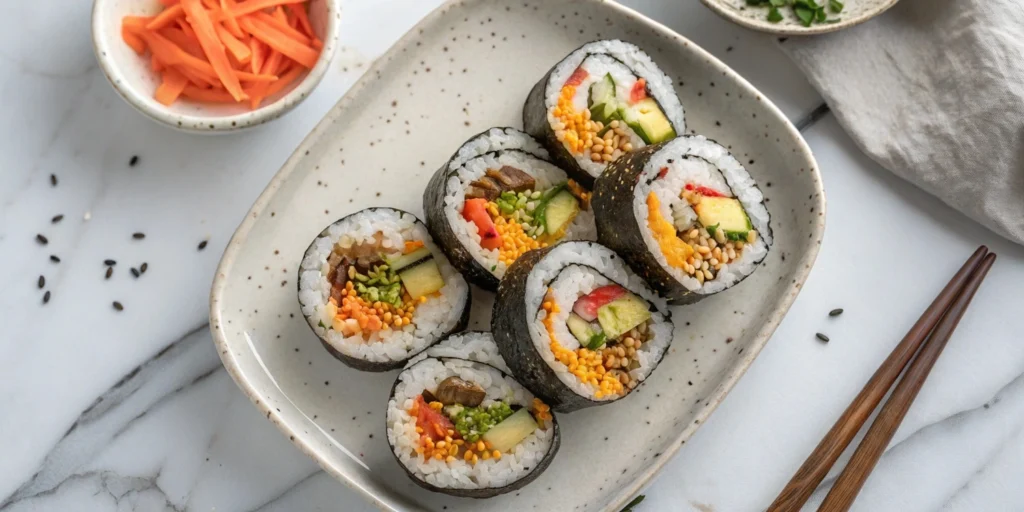
Whether you’re a seasoned cook or a beginner, this recipe will guide you to success. Gather your ingredients, roll up your sleeves, and embark on a delicious journey that’s sure to become a cherished tradition in your home.
Are you ready to create your own kimbap masterpiece? Share your experience in the comments below! Bookmark this recipe and start rolling today. The magic of kimbap awaits you!
